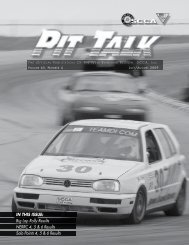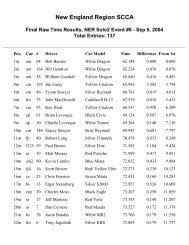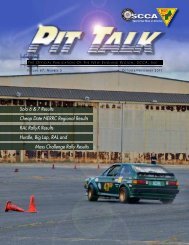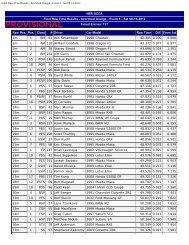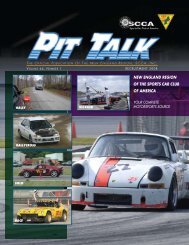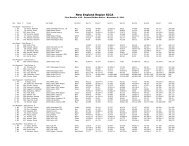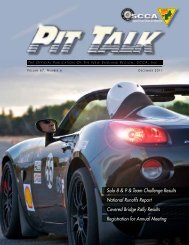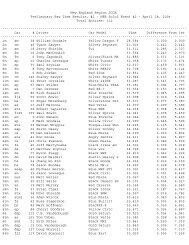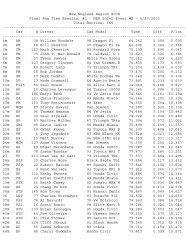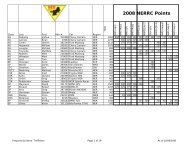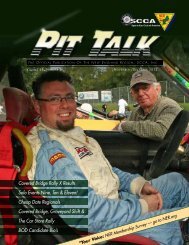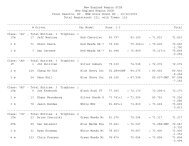ner opens the road racing & solo season dog track rallyx results
ner opens the road racing & solo season dog track rallyx results
ner opens the road racing & solo season dog track rallyx results
You also want an ePaper? Increase the reach of your titles
YUMPU automatically turns print PDFs into web optimized ePapers that Google loves.
disabled vehicle. The fact that <strong>the</strong>re is no passing<br />
allows <strong>the</strong> drivers to slow down without fear of<br />
being overtaken and losing <strong>track</strong> position. Once<br />
<strong>the</strong> yellow goes out, all workers on station should<br />
be looking for passes under <strong>the</strong> yellow, which<br />
will be reported to control and <strong>the</strong> stewards. If<br />
<strong>the</strong> incident (for instance a disabled vehicle) is,<br />
at <strong>the</strong> discretion of <strong>the</strong> stewards not considered<br />
to be a hazard, and will be left in that location<br />
for <strong>the</strong> remainder of <strong>the</strong> session, <strong>the</strong> standing<br />
yellow flag will be held for two laps and <strong>the</strong>n<br />
withdrawn. That vehicle has now become a part<br />
of <strong>the</strong> course.<br />
A waved yellow flag means, “Great danger,<br />
slow down, be prepared to stop, NO PASSING<br />
from <strong>the</strong> flag to <strong>the</strong> incident.” The fact that <strong>the</strong><br />
flag is waved also tells <strong>the</strong> driver that <strong>the</strong>re is<br />
an obstruction on <strong>the</strong> <strong>racing</strong> surface and that<br />
evasive action will most likely be necessary.<br />
It could be a car or a large portion of a car<br />
such as a nose or rear cowling. There may also<br />
be stopped emergency vehicles on <strong>the</strong> <strong>track</strong>.<br />
The practice of “protecting” a cor<strong>ner</strong> worker<br />
responding to a vehicle that is off <strong>the</strong> course by<br />
upgrading from a standing yellow to a waving<br />
yellow is inappropriate, unless <strong>the</strong> worker is<br />
indeed on <strong>the</strong> <strong>track</strong> surface. In ei<strong>the</strong>r case, a<br />
mere flag can never protect a worker.<br />
The new flagger reminder for when to wave, or<br />
not wave, <strong>the</strong> yellow flag is, “Waving on <strong>the</strong><br />
paving; standing in <strong>the</strong> grass...do not pass”.<br />
During a race, double standing yellow flags<br />
may be displayed at ALL stations only at <strong>the</strong><br />
order of <strong>the</strong> operating steward via Control.<br />
This may also be referred to as a “full course<br />
yellow”. Two yellow flags are displayed side by<br />
side by holding <strong>the</strong> sticks toge<strong>the</strong>r in one hand<br />
and <strong>the</strong> free edge of both flags in <strong>the</strong> o<strong>the</strong>r.<br />
The flags can be stabilized and made easier to<br />
hold by rolling <strong>the</strong> flags one turn onto <strong>the</strong> sticks.<br />
Double standing yellow at every station tells <strong>the</strong><br />
driver that “<strong>the</strong> entire course is under a caution<br />
condition, SLOW DOWN, NO PASSING of<br />
o<strong>the</strong>r competitors”. A pace car may be deployed<br />
to control <strong>the</strong> speed of <strong>the</strong> field. Passing of <strong>the</strong><br />
pace car may take place only by a wave-by from<br />
<strong>the</strong> passenger in <strong>the</strong> pace car. This will be done<br />
until <strong>the</strong> leader is behind <strong>the</strong> pace car. Cars may<br />
cautiously pass emergency vehicles and cars<br />
that are disabled and cannot maintain <strong>the</strong> pace,<br />
as indicated by a raised arm on <strong>the</strong> part of <strong>the</strong><br />
slow driver. At <strong>the</strong> site of <strong>the</strong> incident, one flag<br />
may be held stationary and <strong>the</strong> o<strong>the</strong>r waved<br />
to indicate an obstruction on <strong>the</strong> <strong>track</strong>. Double<br />
standing yellow flag condition will also be used,<br />
with or without a pace car, during pace laps<br />
before <strong>the</strong> start of a race or a re-start.<br />
Green Flag<br />
In SCCA club rules, <strong>the</strong> green flag is used to<br />
indicate that <strong>the</strong> race is underway and it is<br />
displayed only by <strong>the</strong> starter. It indicates that <strong>the</strong><br />
course is clear. In certain Pro events, where FIA<br />
and Unified North American Flagging rules are<br />
employed, green flags are also displayed at all<br />
stations for <strong>the</strong> first lap after <strong>the</strong> start (or re-start)<br />
of a race. Likewise, a green flag is displayed<br />
at a station immediately after a station that is<br />
displaying a yellow flag to indicate that <strong>the</strong><br />
course is clear. In such cases, it also delineates<br />
<strong>the</strong> end of <strong>the</strong> no-passing zone in distinction to<br />
<strong>the</strong> site of <strong>the</strong> incident as used in SCCA club<br />
rules.<br />
Blue Flag<br />
The blue flagger is positioned facing up-<strong>track</strong>,<br />
looking right at <strong>the</strong> yellow flagger and at <strong>the</strong><br />
on-coming traffic. THE PRIME RESPONSIBILITY<br />
OF THE BLUE FLAGGER IS TO WATCH THE<br />
—continued on <strong>the</strong> next page<br />
IMPROVED TOURING<br />
PRODUCTION<br />
SHOWROOM STOCK<br />
WORLD CHALLENGE<br />
GRAND AM<br />
TRAILER AND SHOP<br />
“GET . ORGANIZED”<br />
ACCESSORIES<br />
WE SHIP DAILY<br />
Call Peter Mumford, ow<strong>ner</strong> and operator<br />
and make sure you mention SCCA!<br />
Suspension Development & Chassis tuning<br />
Potent Legal Dyno-tuned Engines & Transmissions<br />
Complete Fabrication and Custom Installations<br />
Custom Exhaust Fabrication and Tuning Development<br />
Turn Key Cars and Customer Car Tuning and Service<br />
Available for Test Days for Vehicle Testing and Tuning<br />
Acura and Honda Specialist (o<strong>the</strong>r marques welcome)<br />
Discounts on Safety Equipment and Sparco Gear<br />
2005—ARRC–Congratulations to ITA Champion, Alex<br />
Muresan, with our proven gearbox and brake products<br />
2005—narrc ITA, EP<br />
& ITC Champions<br />
RT2 • Richmond, VT 05477<br />
Anthony Serra’s<br />
6 Dingle Ridge Road<br />
802-434-2239<br />
Toll Free 1-888-297-1032 • Fax 802-434-2036<br />
North Salem, NY 10560<br />
914.669.9679<br />
PIT TALK May 2006 11




